| 4/2015 - 12 |
An Indirect Method and Equipment for Temperature Monitoring and ControlETZ, R. |
| Extra paper information in |
| Click to see author's profile in |
| Download PDF |
Author keywords
DC-DC power converters, digital control, microcontrollers, negative feedback, temperature control
References keywords
spectrometry(16), atomic(15), emission(12), electr(12), plasma(10), tungsten(9), coil(9), vaporization(8), inductively(7), coupled(7)
No common words between the references section and the paper title.
About this article
Date of Publication: 2015-11-30
Volume 15, Issue 4, Year 2015, On page(s): 87 - 94
ISSN: 1582-7445, e-ISSN: 1844-7600
Digital Object Identifier: 10.4316/AECE.2015.04012
Web of Science Accession Number: 000368499800011
SCOPUS ID: 84949969720
Abstract
A new temperature control method for a metallic filament used at high temperature values is proposed by the authors in this paper. The filament used is heated by a switch mode power supply built around a step-down converter. The method uses a microcontroller that implements the temperature control algorithm and also the power supply control loops. The temperature is controlled using a proposed new algorithm based on the output current and output voltage measurements of the power supply already available for implementing the average current mode control. In this way the resistance of the filament can be determined and controlled in a resistance feedback loop. The proposed algorithm will control the resistor value corresponding to the required temperature. The reference resistance value is computed based on the temperature-resistance characteristic of the filament each time a new temperature is introduced in dedicated computer software on a PC. The value is transmitted to the microcontroller via USB interface. The temperature control algorithm and experimentally results are presented in detail in the paper. |
| References | | | Cited By |
Web of Science® Times Cited: 4 [View]
View record in Web of Science® [View]
View Related Records® [View]
Updated 3 weeks, 5 days ago
SCOPUS® Times Cited: 4
View record in SCOPUS® [Free preview]
View citations in SCOPUS® [Free preview]
[1] In-situ Diffusive Gradients in thin-films passive sampling coupled with ex-situ small-sized electrothermal vaporization capacitively coupled plasma microtorch optical emission spectrometry as green and white method for the simultaneous determination of labile species of toxic elements in surface water, Angyus, Simion Bogdan, Senila, Marin, Frentiu, Tiberiu, Ponta, Michaela, Frentiu, Maria, Covaci, Eniko, Talanta, ISSN 0039-9140, Issue , 2023.
Digital Object Identifier: 10.1016/j.talanta.2023.124551 [CrossRef]
[2] Interference-free, green microanalytical method for total mercury and methylmercury determination in biological and environmental samples using small-sized electrothermal vaporization capacitively coupled plasma microtorch optical emission spectrometry, Angyus, Simion Bogdan, Darvasi, Eugen, Ponta, Michaela, Petreus, Dorin, Etz, Radu, Senila, Marin, Frentiu, Maria, Frentiu, Tiberiu, Talanta, ISSN 0039-9140, Issue , 2020.
Digital Object Identifier: 10.1016/j.talanta.2020.121067 [CrossRef]
[3] A microanalytical method based on electrothermal vaporization capacitively coupled plasma microtorch optical emission spectrometry for multielemental determination: comparison with inductively coupled plasma optical emission spectrometry, Frentiu, Tiberiu, Butaciu, Sinziana, Darvasi, Eugen, Ponta, Michaela, Frentiu, Maria, Petreus, Dorin, Chemical Papers, ISSN 2585-7290, Issue 1, Volume 71, 2017.
Digital Object Identifier: 10.1007/s11696-016-0053-z [CrossRef]
Disclaimer: All information displayed above was retrieved by using remote connections to respective databases. For the best user experience, we update all data by using background processes, and use caches in order to reduce the load on the servers we retrieve the information from. As we have no control on the availability of the database servers and sometimes the Internet connectivity may be affected, we do not guarantee the information is correct or complete. For the most accurate data, please always consult the database sites directly. Some external links require authentication or an institutional subscription.
Web of Science® is a registered trademark of Clarivate Analytics, Scopus® is a registered trademark of Elsevier B.V., other product names, company names, brand names, trademarks and logos are the property of their respective owners.
Faculty of Electrical Engineering and Computer Science
Stefan cel Mare University of Suceava, Romania
All rights reserved: Advances in Electrical and Computer Engineering is a registered trademark of the Stefan cel Mare University of Suceava. No part of this publication may be reproduced, stored in a retrieval system, photocopied, recorded or archived, without the written permission from the Editor. When authors submit their papers for publication, they agree that the copyright for their article be transferred to the Faculty of Electrical Engineering and Computer Science, Stefan cel Mare University of Suceava, Romania, if and only if the articles are accepted for publication. The copyright covers the exclusive rights to reproduce and distribute the article, including reprints and translations.
Permission for other use: The copyright owner's consent does not extend to copying for general distribution, for promotion, for creating new works, or for resale. Specific written permission must be obtained from the Editor for such copying. Direct linking to files hosted on this website is strictly prohibited.
Disclaimer: Whilst every effort is made by the publishers and editorial board to see that no inaccurate or misleading data, opinions or statements appear in this journal, they wish to make it clear that all information and opinions formulated in the articles, as well as linguistic accuracy, are the sole responsibility of the author.



